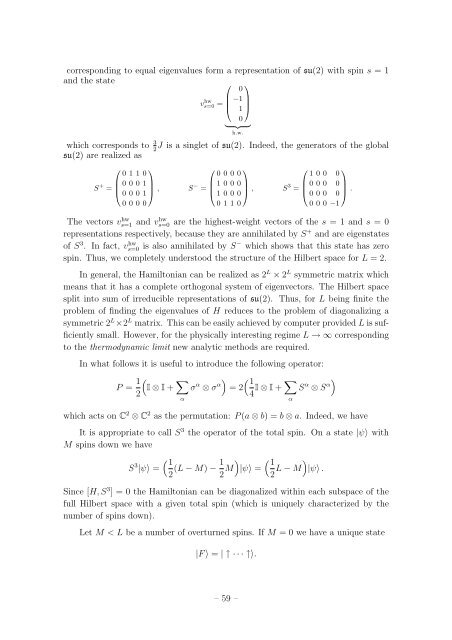Student Seminar: Classical and Quantum Integrable Systems
Student Seminar: Classical and Quantum Integrable Systems
Student Seminar: Classical and Quantum Integrable Systems
You also want an ePaper? Increase the reach of your titles
YUMPU automatically turns print PDFs into web optimized ePapers that Google loves.
corresponding to equal eigenvalues form a representation of su(2) with spin s = 1<br />
<strong>and</strong> the state<br />
⎛ ⎞<br />
0<br />
vs=0 hw = ⎜ −1<br />
⎟<br />
⎝ 1 ⎠<br />
}<br />
0<br />
{{ }<br />
h.w.<br />
which corresponds to 3 J is a singlet of su(2). Indeed, the generators of the global<br />
2<br />
su(2) are realized as<br />
⎛ ⎞<br />
⎛ ⎞<br />
⎛ ⎞<br />
0 1 1 0<br />
0 0 0 0<br />
1 0 0 0<br />
S + = ⎜ 0 0 0 1<br />
⎟<br />
⎝ 0 0 0 1 ⎠ , S− = ⎜ 1 0 0 0<br />
⎟<br />
⎝ 1 0 0 0 ⎠ , S3 = ⎜ 0 0 0 0<br />
⎟<br />
⎝ 0 0 0 0 ⎠ .<br />
0 0 0 0<br />
0 1 1 0<br />
0 0 0 −1<br />
The vectors vs=1 hw <strong>and</strong> vs=0 hw are the highest-weight vectors of the s = 1 <strong>and</strong> s = 0<br />
representations respectively, because they are annihilated by S + <strong>and</strong> are eigenstates<br />
of S 3 . In fact, vs=0 hw is also annihilated by S − which shows that this state has zero<br />
spin. Thus, we completely understood the structure of the Hilbert space for L = 2.<br />
In general, the Hamiltonian can be realized as 2 L × 2 L symmetric matrix which<br />
means that it has a complete orthogonal system of eigenvectors. The Hilbert space<br />
split into sum of irreducible representations of su(2). Thus, for L being finite the<br />
problem of finding the eigenvalues of H reduces to the problem of diagonalizing a<br />
symmetric 2 L ×2 L matrix. This can be easily achieved by computer provided L is sufficiently<br />
small. However, for the physically interesting regime L → ∞ corresponding<br />
to the thermodynamic limit new analytic methods are required.<br />
In what follows it is useful to introduce the following operator:<br />
P = 1 2<br />
(<br />
I ⊗ I + ∑ α<br />
) ( 1<br />
σ α ⊗ σ α = 2<br />
4 I ⊗ I + ∑ α<br />
S α ⊗ S α )<br />
which acts on C 2 ⊗ C 2 as the permutation: P (a ⊗ b) = b ⊗ a. Indeed, we have<br />
It is appropriate to call S 3 the operator of the total spin. On a state |ψ〉 with<br />
M spins down we have<br />
S 3 |ψ〉 =<br />
( 1<br />
2 (L − M) − 1 ) ( 1<br />
)<br />
2 M |ψ〉 =<br />
2 L − M |ψ〉 .<br />
Since [H, S 3 ] = 0 the Hamiltonian can be diagonalized within each subspace of the<br />
full Hilbert space with a given total spin (which is uniquely characterized by the<br />
number of spins down).<br />
Let M < L be a number of overturned spins. If M = 0 we have a unique state<br />
|F 〉 = | ↑ · · · ↑〉.<br />
– 59 –

















